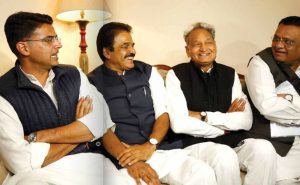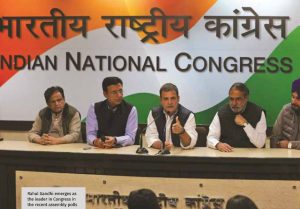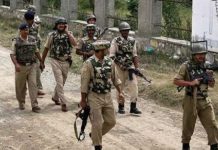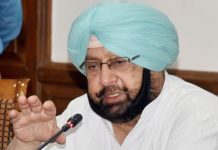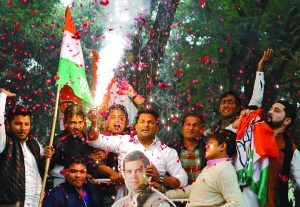 The BJP lost elections in all the five states in the recent Assembly polls. Three of them Rajasthan, Madhya Pradesh and Chhattisgarh were rules by the saffron party. Only a week before the five states went to polls, no one in media was ready to believe any suggestion of possible debacle of BJP. The TV coverage over assembly polls in Rajasthan, Madhya Pradesh, Chhattisgarh, Telangana and Mizoram were largely lopsided. Newspapers too were carrying out agenda of the Sangh Parivar by providing more space to Ram Mandir issue. However, the political circle in the national capital had at least some indication of what was going on in the minds of people.
The BJP lost elections in all the five states in the recent Assembly polls. Three of them Rajasthan, Madhya Pradesh and Chhattisgarh were rules by the saffron party. Only a week before the five states went to polls, no one in media was ready to believe any suggestion of possible debacle of BJP. The TV coverage over assembly polls in Rajasthan, Madhya Pradesh, Chhattisgarh, Telangana and Mizoram were largely lopsided. Newspapers too were carrying out agenda of the Sangh Parivar by providing more space to Ram Mandir issue. However, the political circle in the national capital had at least some indication of what was going on in the minds of people.
Otherwise, they would not have gathered in the capital to show solidarity with the Rahul Gandhi. They were hardly ready to accept him till few months back. Now they were expressing faith in his ability to build up a momentum against the Modi government. They had sensed that Prime Minister Narendra Modi was fast losing his ground. However, a well-organised campaign in media was not allowing the proposition to grow till results were announced. The invincibility of Narendra Modi-Amit Shah was being sold with all vigour. The practice has not died down even after the collapse of the saffron party in five states. Reasons of debacle are being discovered in failures of local leaderships. The chief ministers of the three states are being held responsible for it. Very few in the media are ready to accept the emergence of Congress as the winner and the gains are being portrayed as unexpected ones. Is this a right perspective?
The Congress could not reverse the tally in Madhya Pradesh and it was photo finish with Congress having 114 seats and BJP 109. The BJP lost 56 of 165 seats it had won in 2013. The Congress had only 58 seats. The percentage of votes to BJP dropped by 4 per cent and it gained 41 per cent. The Congress gained 4.5 per cent of the vote and won 40.9 per cent. The BJP had won 27 seats with 54.76 per cent of the vote in 2014 Lok Sabha elections. The Congress had a vote share of 35 per cent and could win only 2 seats. If we project the scenario of 2019 polls, the Congress is expected to win 12 seats and BJP 17.
The result in Rajasthan was not different so far as the vote share is concerned. The Congress has 39.3 per cent and BJP has 38.8 per cent. The Congress won 99 seats and the BJP 73. The tally in 2013 was 21 and 163 for Congress and BJP respectively. The BJP lost 6.2 per cent of the vote and Congress gained 6.4 per cent. If we take into account vote and seat share of 2014 Lok Sabha elections, there was a wide gap. The BJP had swept the polls and Congress failed to gain any seat. Projections for 2019 suggest 13 seats to BJP and 12 to Congress.
In Chhattisgarh, the Congress has got 43.2 per cent of the vote and the BJP 32.9 per cent. The BJP lost 8 per cent of the vote it had gained in 2013. However, the Congress could gain only 2 per cent of it. The remaining vote went to others including BSP. The Congress swept the polls and got 68 seats. The BJP won only 15 seats. The projections for 2019 polls suggest 10 Lok Sabha seats to Congress and 1 to BJP. In 2014, the Congress had won only 1 and the BJP 10. In 2014, the vote share of BJP was 49.6 per cent. The Congress could get only 39 per cent.
In Telangana, the TRS-led by K Chandrashekhar Rao swept the polls by taking 88 seats of 119 seats. The Congress got only 19 seats and the BJP 1. The ruling party got 26.9 per cent of the vote and the Congress 28.4 per cent. The AIMIM led by Owaisi won 7 seats.
In Mizoram, the Mizo National Front got a decisive victory over Congress. The party got 26 of 40 seats. The Congress could win only 5 seats. In 2013, the Congress had got 34 and the MNF 5 seats. The MNF won 37.6 per cent of the vote and Congress 30.2 per cent. The Congress lost 14.4 per cent of the vote it had gained in 2013.
If we examine the political developments that had preceded the state polls, we can gain some insight of what was going on in these regions. The BJP was losing successive bypolls and civic polls and it had started just after Modi took over. The pace was accelerated afterwards and we saw how an opposition unity brought victory in Gorakhpur and Phoolpur in Uttar Pradesh. Gorakhpur seat was held by Chief Minister Adityanath Yogi. But the BJP leadership was not ready to analyse these debacles. The signs of decline were all visible but the party chose to ignore it.
While the BJP was ignoring the visible symptoms, Rahul Gandhi was building up a narrative against Modi. When BJP was not ready to go into the reasons of decline, Rahul Gandhi was properly articulating an agenda. “Youth of the states, farmers, small businesses have supported us. We have a commitment to them and we are going to provide the states with a vision and a government they can be proud of,” Rahul Gandhi said after the poll results.
“People of India have given a clear mandate to ‘chowkidar’ we will not stand for corruption and crony capitalism. We demand a Joint Parliamentary Committee investigate Rafale scam. Please sign this petition to bring back transparency,” says Rahul Gandhi.
“Mr Modi has taught me what not to do. He refused to listen to youngsters and farmers. Arrogance is fatal for a politician”, he asserted.
Rahul was taking on the government on demonetisation and GST and Modi’s response was negative. He was busy with attacking the “dynasty”. He went to the extent of alleging that the family (Gandhi family) was crying over demonetization and the people are celebrating. He was mocking Gandhis. Even after the report of most of the currency notes were deposited, the government was not ready to accept the folly.
The response towards allegations of corruption in Rafale deal remained negative and arrogant. Modi government chose to open up cases related to Robert Vadra and P Chidambaram in the anticipation that the image of the Congress would get an irreparable damage. The method was adopted so wildly that raids were conducted on the premises of Vadra’s offices to coincide the assembly polls. It came as no surprise that a corruption was leaked to media to allege impropriety against Priyanka and Rahul Gandhi while dealing with a tenant in their ancestral farm house in Delhi.
The Prime Minister lost control over his narrative on development and even did not hesitate to issue a threat to the Gandhi family. He asserted in an election rally in Rajasthan that Christian Michel, the alleged middleman in AugustaWestland VVIP chopper deal had been extradited from Dubai and he might start spilling beans. He also referred to the National Herald case and said, “Now I see how you escape.”
Of late, attack on dynasty became a major theme of Modi’s poll speeches. What was his strategy behind the attack? It is clear that Modi-Shah wanted to Modi versus Rahul scenario in state polls. This harmed the party immensely. It helped the Congress as it had entered the polls without local faces. In contrast, the BJP had credible faces in states like Madhya Pradesh and Chhattisgarh. Despite an anti-incumbency of three terms, both Raman Singh and Shivraj Singh were popular leaders and had the ability to counter, at least part of, anti- incumbency. Modi versus Rahul scenario led to the reduction of their winning capability. However, MP chief minister Shivraj Singh could give a big fight and could win the number seats that was equal to what Congress became able to grab. Experts are of the opinion that had these leaders were allowed to carry on, they would have won few more seats. The debacle in Chhattisgarh would not have been so humiliating.
A look at the response of the ruling party to the polls results reveals the arrogance. Except for the chief ministers who lost the battle, none of the BJP leaders congratulated the Congress. All of them are congratulating their chief ministers of doing great job in their respective states. Party president Amit Shah did not bother to comment on the polls on day the results were announced. Shah has been portrayed as the master strategist with capabilities that have no parallels.
In contrast, Rahul thanked the outgoing chief ministers for the job they have done in their respective states and assured them that his party would not go for witch-hunting. He also asserted that he does not believe in such things like ‘BJP-free nation’.
The battle for 2019 Lok Sabha polls has been on since many months now. However, the final game has started after the results in five assemblies. The poll results have drastically changed the equation. Only few months ago, enthusiasts like West Bengal Chief Minister Mamata Banerjee and Telangana Chief Minister K Chandra Shekhar Rao were working for a Federal Front which will neither BJP nor Congress in it. Though the idea was abandoned at the insistence of Andhra Chief Minister Candrabu Naidu and Maratha stalwart Sharad Pawar, there were chances of its revival after the assembly polls in case of Congress’ failure to force a defeat on BJP. The results changed the scenario. The most noticeable of it was in the responses of Akhilesh Yadav and Maywati. Both of them had refused to join the alliance Congress wanted to forge against the BJP in the poll bound states. Both of them also skipped the meeting of opposition leaders in Delhi. But they fell in line soon after the results were out. They declared their support to Congress in Rajastahan and Madhya Pradesh. The BSP has two seats in Madhya Pradesh and one Rajasthan. The Samajwadi party has one seat in Madhya Pradesh.
The acknowledgement proves the acumen of Rahul Gandhi as a politician. if we closely look at the pre-poll scenario in the three states of Hindi heartland, we can easily understand the uphill task he had in hand. In Madhya Pradesh, the party organization was almost non-existent. There were many factions within the party. All the three big leaders including Digvijay Singh, Kamal Nath and Jyotiraditya Scindhia were not working against each other. Rahul Gandhi not only forced them to become united. He could build up a narrative around the issue of farm distress. His strategy worked. Shivraj Singh had his welfare measures and his image of a simple person to back him, but it did not work.
In Rajasthan, Rahul had a relative advantage in having an opponent who was arrogant and non-performing. The issue of unemployment and poor governance played an important role in the elections. Youth was asking for the 15 Lakh jobs they were promised in 2013. The farmers were asking for the relief they have been repeatedly promised by the BJP. But this advantage was neutralized by the infighting within the party. Two important leaders of the state, Ashok Gehlot and Sachin Pilot were not ready to accept each other. Supporters of Gehlot fought against the official candidates of the party and few succeeded in getting elected. The infighting took its tall. The party could just manage to touch the magic favor with its ally Rashtriya Lok Dal. Rahul has to manage the state in his own way.
The success in Chhattisgarh has lot to do with the social strategy. He allowed Mandalization of the party under the leadership of Bhupesh Baghel, a Kurmi leader. The Congress also roped in Tamradhwaj Sahu, a Teli leader to woo numerically strong community. Both of them were projected as unofficial chief ministerial candidates. The vote share in Chhatisgarh suggest that his social strategy worked well and the party could win a landslide victory.
In addition to forging state specific social alliances, Rahul built up common narrative for the states against corruption, unemployment and farm distress. The results show that BJP’s social strategy in states failed to deliver this time. These strategies had its routes in Vajpayee era. Party had an OBC as the leader and a Rajput, a dominant caste in the state, as leader. The party had considerable support base among Scheduled Castes in MP. In Rajasthan, it had the support of Jats and Gujjar. In Chhattisgarh, the party was strong Scheduled Tribe dominated areas. The party seemed to have lost ground among these communities. The most unlikely of the development was desertion by Jats and Gujjars.
The most interesting outcome was in Telangana. The astounding victory of TRS in the state has lot of political implications at the national level. The dismal performance of TDP in the state will impact its alliance with the Congress. Another thing would be renewed effort by Chief Minister KCR to forge a Federal Front without BJP and the Congress. His effort would affect both the national parties because he would try to woo people like Nitish Kumar, Arvind Kejriwal, Navin Patnaik and Mamata Banerjee. This would affect the overall national discourse on alternative to Modi. KCR may not get much success in his effort but he would certainly spoil prospects of Congress to a great extent by shifting the discourse on alternative.
Telangana results has also impacted BJP in a big way and stopped its march in south India. The party was eyeing for an expansion and had made some inroad in Telangana and Andhra Pradesh. It was trying to project itself as a national alternative to the Congress in the region. The party will have to reconcile to a marginal role in the region.
Modi cannot be expected to quietly accept the debacle as it is. He has been looking for change in his banking policy for quite some time. In fact, his confrontation with the Reserve Bank of India is largely political. He is trying to use the reserve of the apex bank to finance his welfare programs for small business and farming people. The government is also trying to stop the downslide of the economy by recapitalising banks that are not performing well. The government is getting pressures from corporate to do it urgently. This is the reason former finance secretary has Shaktikant Das has been made governor of RBI. A bureaucrat without any degree or research experience in economics is expected to completely toe the government line.
The things are not quite right for Modi on other fronts too. The Supreme Court is to deliver judgments on the CBI controversy and hardliners in Sangh Parivar is likely to accelerate the Ram Mandir movement. This will not be easy for Modi to handle. If RSS goes slow on the issue, it will be difficult for the organization to push it again. However, a practical assessment by BJP leadership may not opt go for an increased momentum to the issue for it has failed to help BJP in retaining the Hindi states. Yogi Adityanath failed in polarizing people I the states by his sloganeering on the issue. Even PM Modi wanted to corner Congress on the issue. However, it would be impractical on the part of the Congress to expect the RSS to go silent on the issue. The demand for a legislation for a temple in Ayodhya will be made by the organization is almost certain. The Congress has to counter it a proper strategy because Owaisi and others are there to help BJP in polarizing the atmosphere.
Rahul has also face the challenge of good governance in the states the Congress has won. He has to fulfill some of his promises before the 2019 polls. It would not be easy for him because he has a hostile government at the centre. The centre will not help him financially in waiving farm loans or giving Minimum Support Price. He has to invent his own way to run these states till the Lok Sabha polls are over.
letters@tehelka.com

